University Project: Risk Analysis and Mitigation - Flinders Rail Link
VerifiedAdded on 2022/11/25
|8
|1570
|58
Project
AI Summary
This project management assignment provides a comprehensive risk analysis of the Flinders Rail Link project. It begins with the identification and qualitative analysis of risks using methods like root cause analysis and the Delphi method, focusing on environmental and operational risks such as noise and train speed control. The assessment includes both qualitative and quantitative evaluations. The assignment then outlines risk mitigation strategies, including noise reduction measures and operational adjustments to manage train speed. It further details risk monitoring processes, assigning responsibilities to an environmental manager and a tester, to ensure compliance and operational efficiency. The project incorporates relevant bibliography to support the analysis.
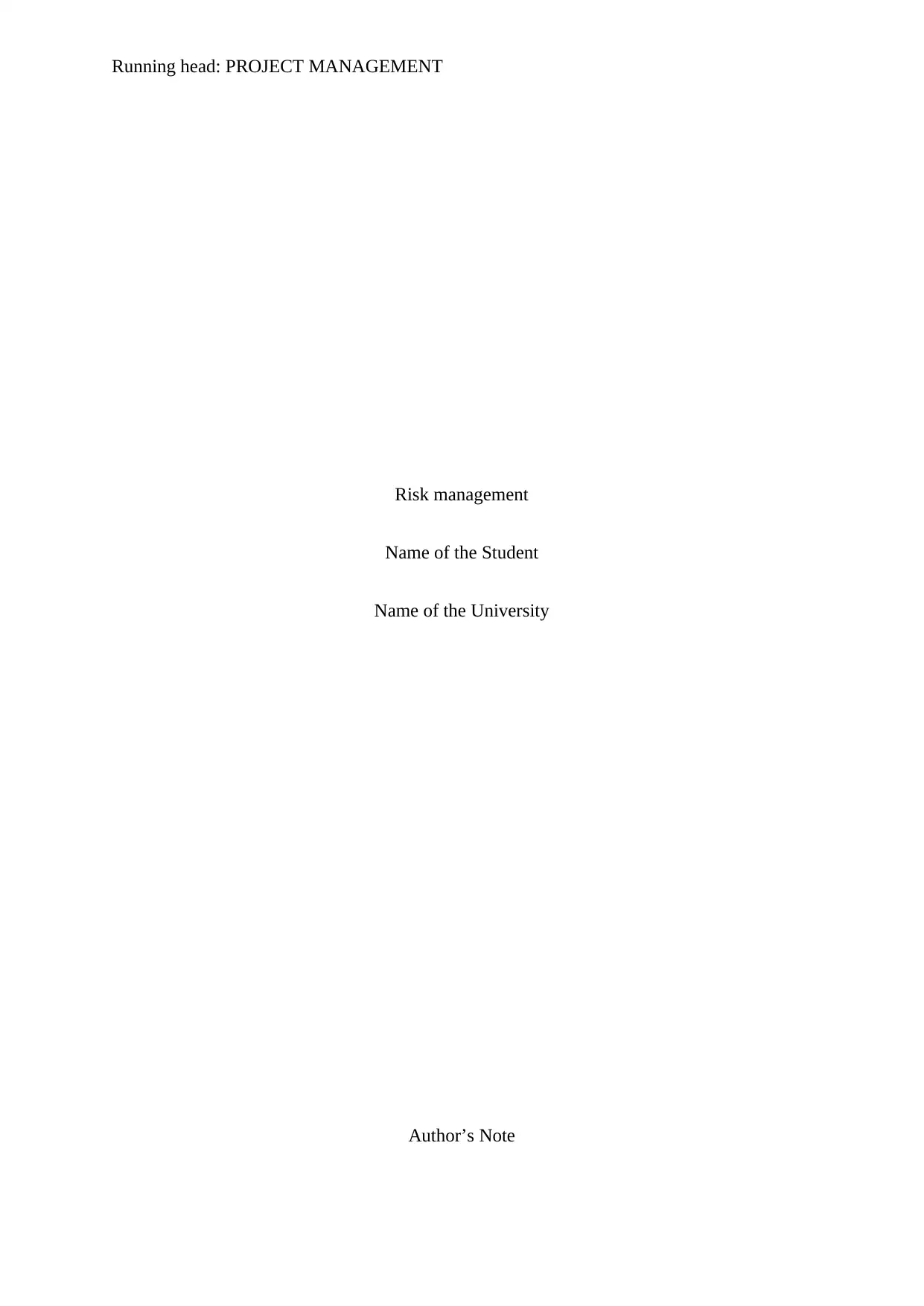
Running head: PROJECT MANAGEMENT
Risk management
Name of the Student
Name of the University
Author’s Note
Risk management
Name of the Student
Name of the University
Author’s Note
Paraphrase This Document
Need a fresh take? Get an instant paraphrase of this document with our AI Paraphraser
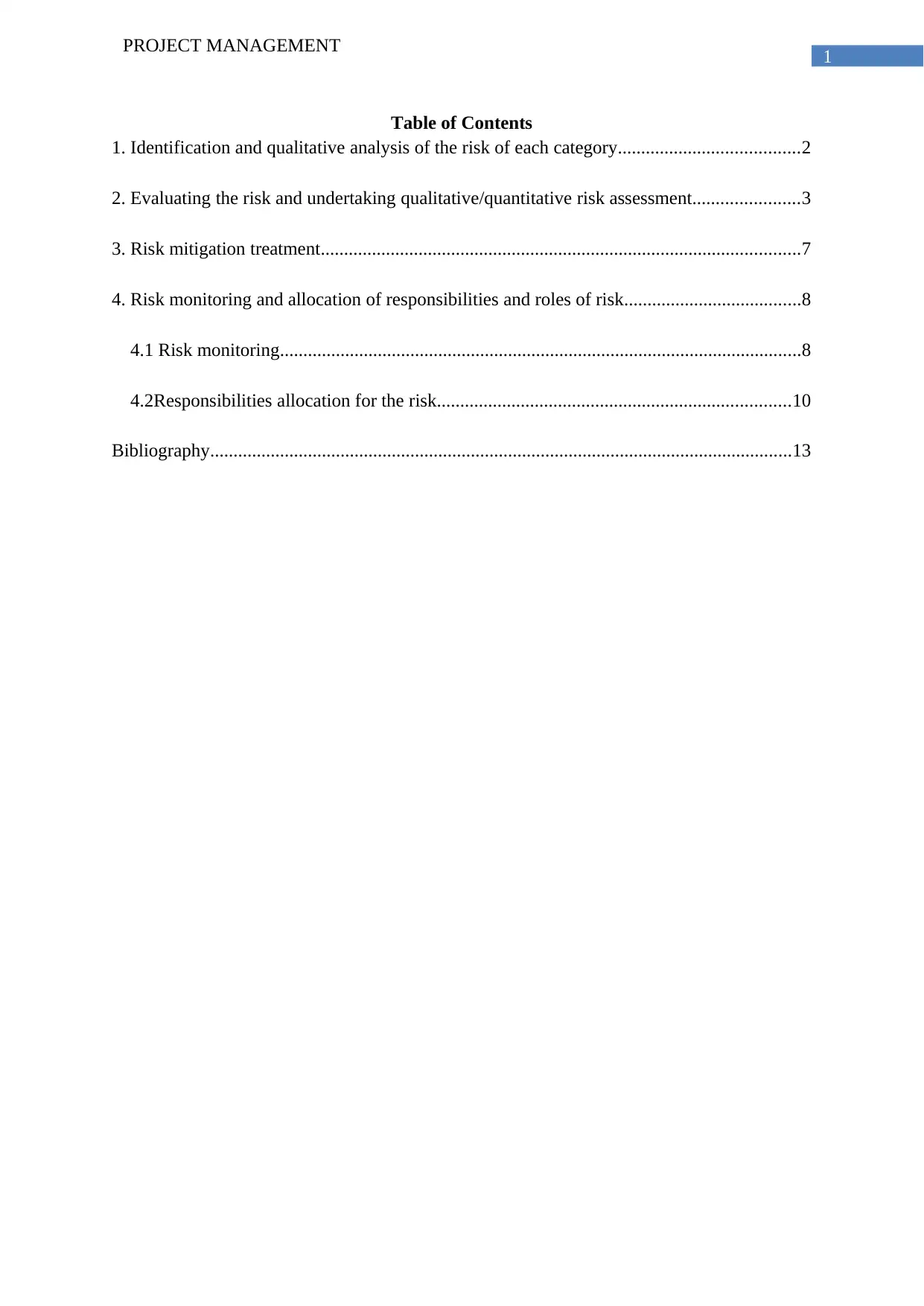
1
PROJECT MANAGEMENT
Table of Contents
1. Identification and qualitative analysis of the risk of each category.......................................2
2. Evaluating the risk and undertaking qualitative/quantitative risk assessment.......................3
3. Risk mitigation treatment.......................................................................................................7
4. Risk monitoring and allocation of responsibilities and roles of risk......................................8
4.1 Risk monitoring................................................................................................................8
4.2Responsibilities allocation for the risk............................................................................10
Bibliography.............................................................................................................................13
PROJECT MANAGEMENT
Table of Contents
1. Identification and qualitative analysis of the risk of each category.......................................2
2. Evaluating the risk and undertaking qualitative/quantitative risk assessment.......................3
3. Risk mitigation treatment.......................................................................................................7
4. Risk monitoring and allocation of responsibilities and roles of risk......................................8
4.1 Risk monitoring................................................................................................................8
4.2Responsibilities allocation for the risk............................................................................10
Bibliography.............................................................................................................................13
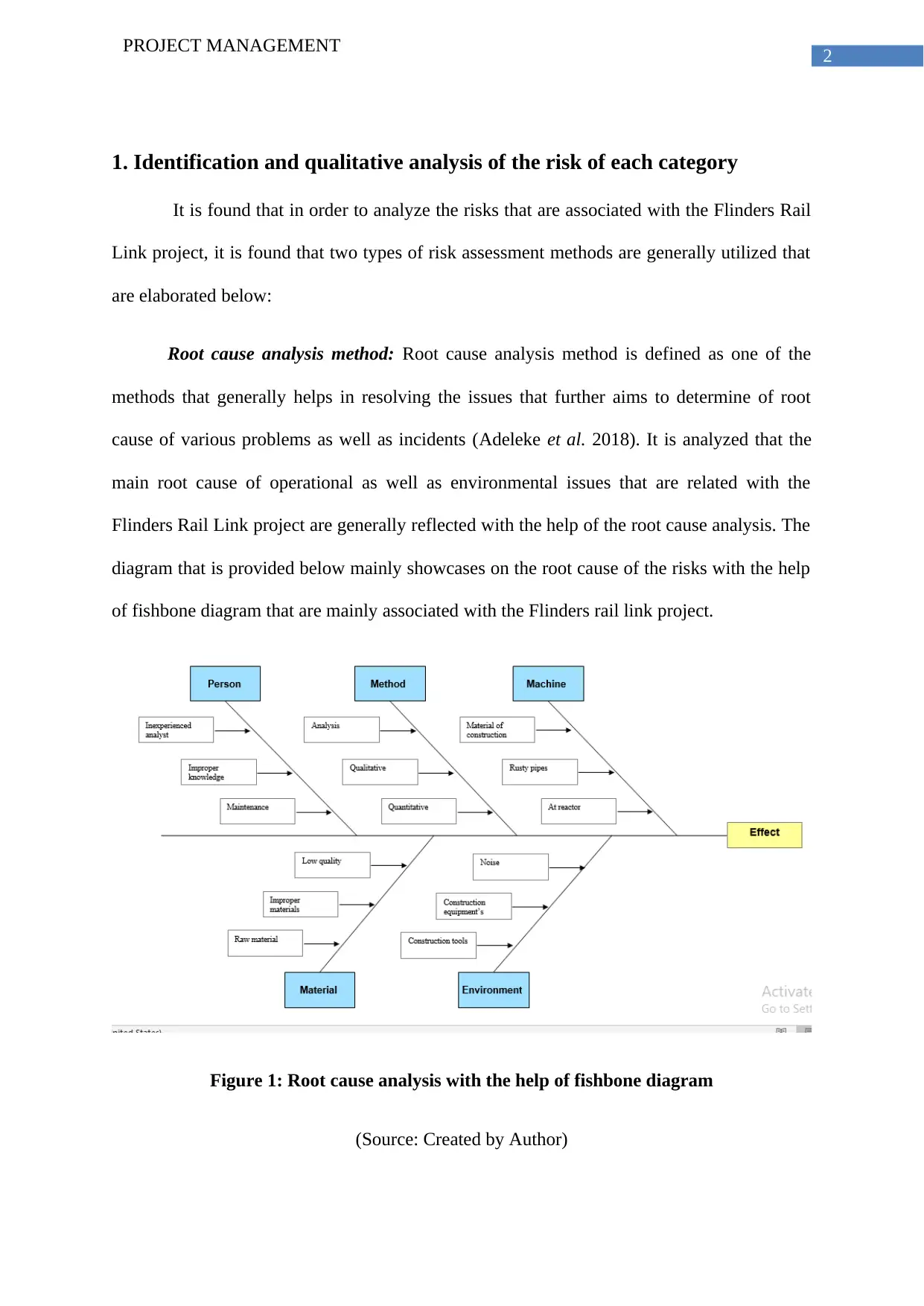
2
PROJECT MANAGEMENT
1. Identification and qualitative analysis of the risk of each category
It is found that in order to analyze the risks that are associated with the Flinders Rail
Link project, it is found that two types of risk assessment methods are generally utilized that
are elaborated below:
Root cause analysis method: Root cause analysis method is defined as one of the
methods that generally helps in resolving the issues that further aims to determine of root
cause of various problems as well as incidents (Adeleke et al. 2018). It is analyzed that the
main root cause of operational as well as environmental issues that are related with the
Flinders Rail Link project are generally reflected with the help of the root cause analysis. The
diagram that is provided below mainly showcases on the root cause of the risks with the help
of fishbone diagram that are mainly associated with the Flinders rail link project.
Figure 1: Root cause analysis with the help of fishbone diagram
(Source: Created by Author)
PROJECT MANAGEMENT
1. Identification and qualitative analysis of the risk of each category
It is found that in order to analyze the risks that are associated with the Flinders Rail
Link project, it is found that two types of risk assessment methods are generally utilized that
are elaborated below:
Root cause analysis method: Root cause analysis method is defined as one of the
methods that generally helps in resolving the issues that further aims to determine of root
cause of various problems as well as incidents (Adeleke et al. 2018). It is analyzed that the
main root cause of operational as well as environmental issues that are related with the
Flinders Rail Link project are generally reflected with the help of the root cause analysis. The
diagram that is provided below mainly showcases on the root cause of the risks with the help
of fishbone diagram that are mainly associated with the Flinders rail link project.
Figure 1: Root cause analysis with the help of fishbone diagram
(Source: Created by Author)
⊘ This is a preview!⊘
Do you want full access?
Subscribe today to unlock all pages.

Trusted by 1+ million students worldwide
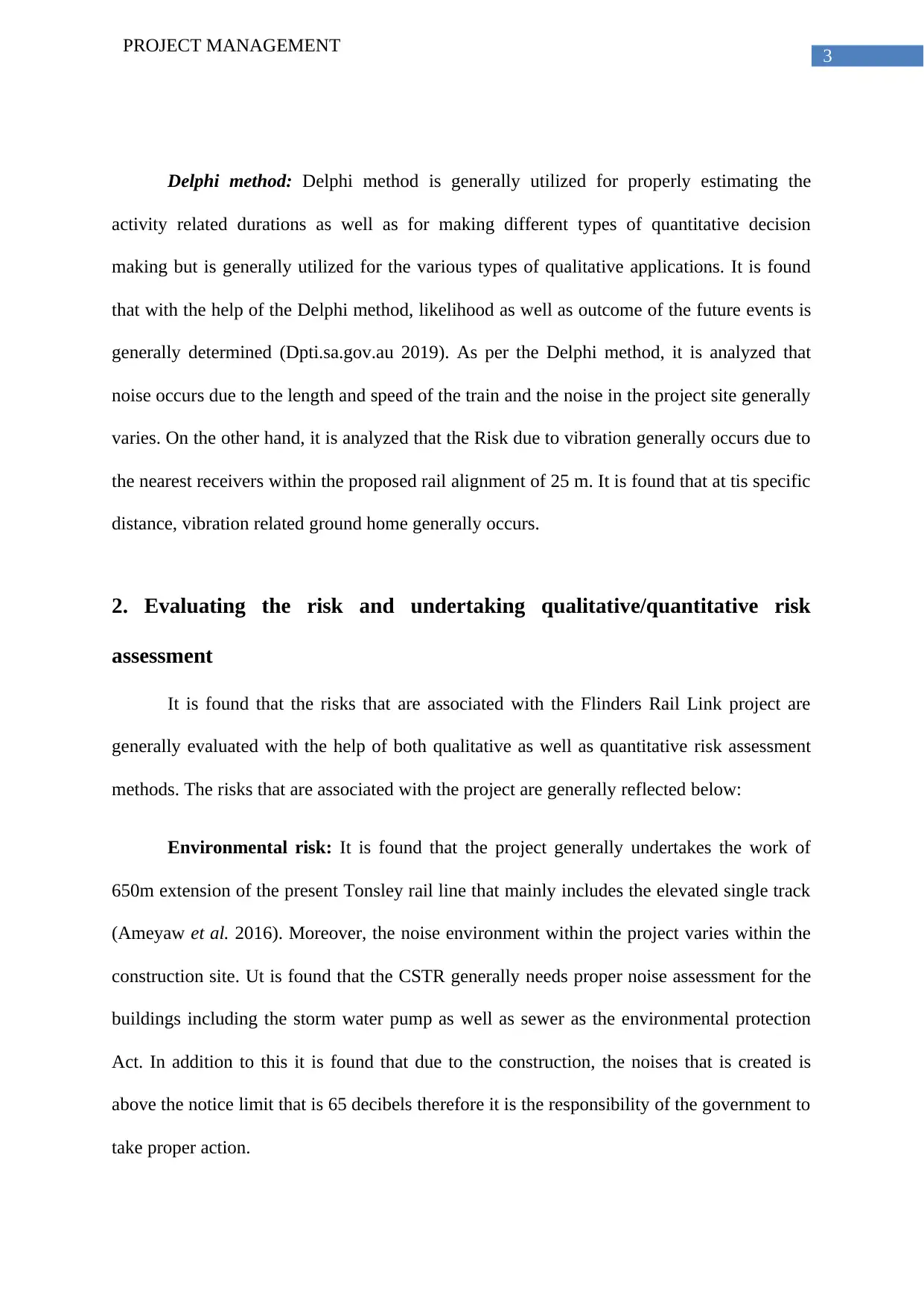
3
PROJECT MANAGEMENT
Delphi method: Delphi method is generally utilized for properly estimating the
activity related durations as well as for making different types of quantitative decision
making but is generally utilized for the various types of qualitative applications. It is found
that with the help of the Delphi method, likelihood as well as outcome of the future events is
generally determined (Dpti.sa.gov.au 2019). As per the Delphi method, it is analyzed that
noise occurs due to the length and speed of the train and the noise in the project site generally
varies. On the other hand, it is analyzed that the Risk due to vibration generally occurs due to
the nearest receivers within the proposed rail alignment of 25 m. It is found that at tis specific
distance, vibration related ground home generally occurs.
2. Evaluating the risk and undertaking qualitative/quantitative risk
assessment
It is found that the risks that are associated with the Flinders Rail Link project are
generally evaluated with the help of both qualitative as well as quantitative risk assessment
methods. The risks that are associated with the project are generally reflected below:
Environmental risk: It is found that the project generally undertakes the work of
650m extension of the present Tonsley rail line that mainly includes the elevated single track
(Ameyaw et al. 2016). Moreover, the noise environment within the project varies within the
construction site. Ut is found that the CSTR generally needs proper noise assessment for the
buildings including the storm water pump as well as sewer as the environmental protection
Act. In addition to this it is found that due to the construction, the noises that is created is
above the notice limit that is 65 decibels therefore it is the responsibility of the government to
take proper action.
PROJECT MANAGEMENT
Delphi method: Delphi method is generally utilized for properly estimating the
activity related durations as well as for making different types of quantitative decision
making but is generally utilized for the various types of qualitative applications. It is found
that with the help of the Delphi method, likelihood as well as outcome of the future events is
generally determined (Dpti.sa.gov.au 2019). As per the Delphi method, it is analyzed that
noise occurs due to the length and speed of the train and the noise in the project site generally
varies. On the other hand, it is analyzed that the Risk due to vibration generally occurs due to
the nearest receivers within the proposed rail alignment of 25 m. It is found that at tis specific
distance, vibration related ground home generally occurs.
2. Evaluating the risk and undertaking qualitative/quantitative risk
assessment
It is found that the risks that are associated with the Flinders Rail Link project are
generally evaluated with the help of both qualitative as well as quantitative risk assessment
methods. The risks that are associated with the project are generally reflected below:
Environmental risk: It is found that the project generally undertakes the work of
650m extension of the present Tonsley rail line that mainly includes the elevated single track
(Ameyaw et al. 2016). Moreover, the noise environment within the project varies within the
construction site. Ut is found that the CSTR generally needs proper noise assessment for the
buildings including the storm water pump as well as sewer as the environmental protection
Act. In addition to this it is found that due to the construction, the noises that is created is
above the notice limit that is 65 decibels therefore it is the responsibility of the government to
take proper action.
Paraphrase This Document
Need a fresh take? Get an instant paraphrase of this document with our AI Paraphraser
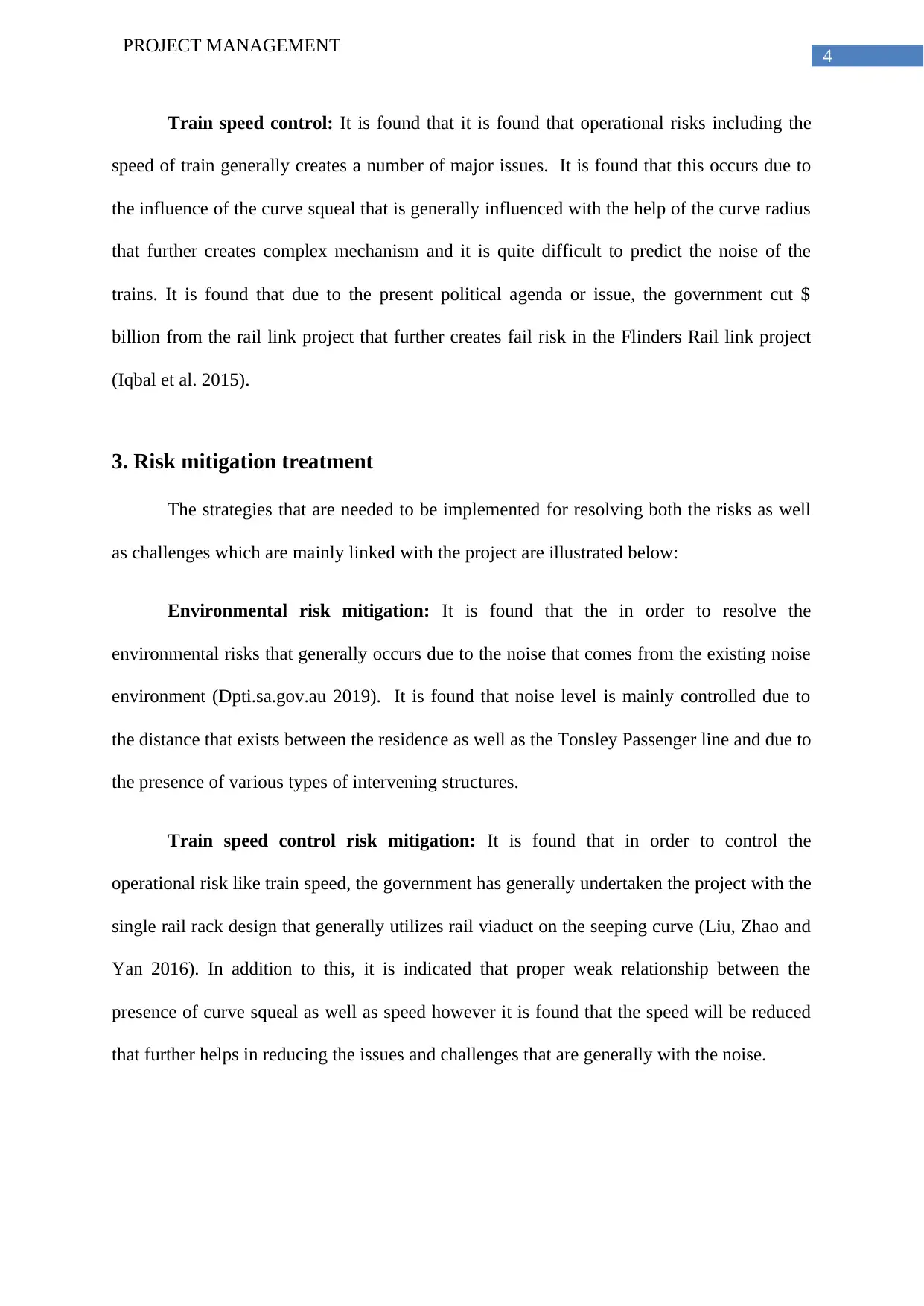
4
PROJECT MANAGEMENT
Train speed control: It is found that it is found that operational risks including the
speed of train generally creates a number of major issues. It is found that this occurs due to
the influence of the curve squeal that is generally influenced with the help of the curve radius
that further creates complex mechanism and it is quite difficult to predict the noise of the
trains. It is found that due to the present political agenda or issue, the government cut $
billion from the rail link project that further creates fail risk in the Flinders Rail link project
(Iqbal et al. 2015).
3. Risk mitigation treatment
The strategies that are needed to be implemented for resolving both the risks as well
as challenges which are mainly linked with the project are illustrated below:
Environmental risk mitigation: It is found that the in order to resolve the
environmental risks that generally occurs due to the noise that comes from the existing noise
environment (Dpti.sa.gov.au 2019). It is found that noise level is mainly controlled due to
the distance that exists between the residence as well as the Tonsley Passenger line and due to
the presence of various types of intervening structures.
Train speed control risk mitigation: It is found that in order to control the
operational risk like train speed, the government has generally undertaken the project with the
single rail rack design that generally utilizes rail viaduct on the seeping curve (Liu, Zhao and
Yan 2016). In addition to this, it is indicated that proper weak relationship between the
presence of curve squeal as well as speed however it is found that the speed will be reduced
that further helps in reducing the issues and challenges that are generally with the noise.
PROJECT MANAGEMENT
Train speed control: It is found that it is found that operational risks including the
speed of train generally creates a number of major issues. It is found that this occurs due to
the influence of the curve squeal that is generally influenced with the help of the curve radius
that further creates complex mechanism and it is quite difficult to predict the noise of the
trains. It is found that due to the present political agenda or issue, the government cut $
billion from the rail link project that further creates fail risk in the Flinders Rail link project
(Iqbal et al. 2015).
3. Risk mitigation treatment
The strategies that are needed to be implemented for resolving both the risks as well
as challenges which are mainly linked with the project are illustrated below:
Environmental risk mitigation: It is found that the in order to resolve the
environmental risks that generally occurs due to the noise that comes from the existing noise
environment (Dpti.sa.gov.au 2019). It is found that noise level is mainly controlled due to
the distance that exists between the residence as well as the Tonsley Passenger line and due to
the presence of various types of intervening structures.
Train speed control risk mitigation: It is found that in order to control the
operational risk like train speed, the government has generally undertaken the project with the
single rail rack design that generally utilizes rail viaduct on the seeping curve (Liu, Zhao and
Yan 2016). In addition to this, it is indicated that proper weak relationship between the
presence of curve squeal as well as speed however it is found that the speed will be reduced
that further helps in reducing the issues and challenges that are generally with the noise.
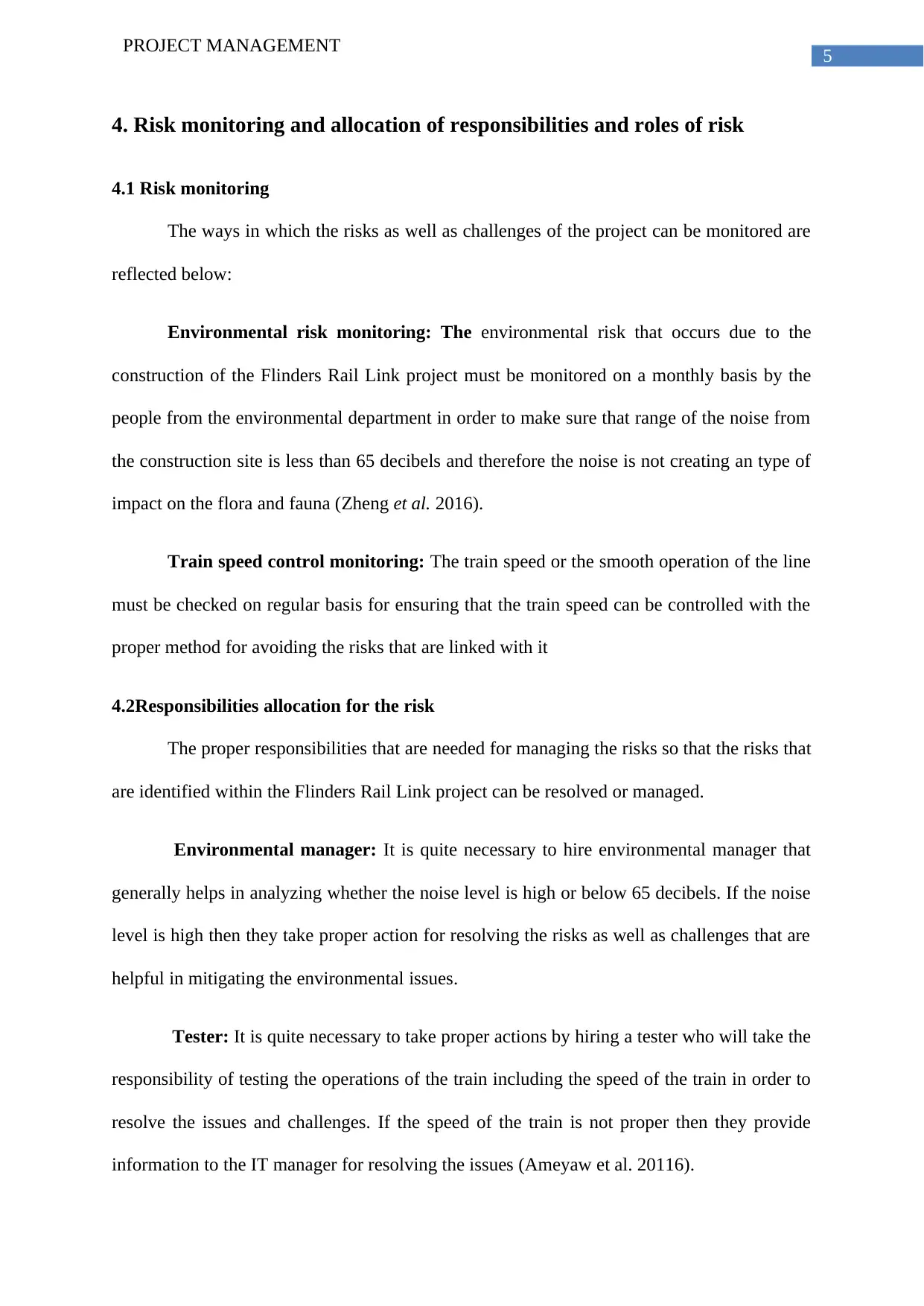
5
PROJECT MANAGEMENT
4. Risk monitoring and allocation of responsibilities and roles of risk
4.1 Risk monitoring
The ways in which the risks as well as challenges of the project can be monitored are
reflected below:
Environmental risk monitoring: The environmental risk that occurs due to the
construction of the Flinders Rail Link project must be monitored on a monthly basis by the
people from the environmental department in order to make sure that range of the noise from
the construction site is less than 65 decibels and therefore the noise is not creating an type of
impact on the flora and fauna (Zheng et al. 2016).
Train speed control monitoring: The train speed or the smooth operation of the line
must be checked on regular basis for ensuring that the train speed can be controlled with the
proper method for avoiding the risks that are linked with it
4.2Responsibilities allocation for the risk
The proper responsibilities that are needed for managing the risks so that the risks that
are identified within the Flinders Rail Link project can be resolved or managed.
Environmental manager: It is quite necessary to hire environmental manager that
generally helps in analyzing whether the noise level is high or below 65 decibels. If the noise
level is high then they take proper action for resolving the risks as well as challenges that are
helpful in mitigating the environmental issues.
Tester: It is quite necessary to take proper actions by hiring a tester who will take the
responsibility of testing the operations of the train including the speed of the train in order to
resolve the issues and challenges. If the speed of the train is not proper then they provide
information to the IT manager for resolving the issues (Ameyaw et al. 20116).
PROJECT MANAGEMENT
4. Risk monitoring and allocation of responsibilities and roles of risk
4.1 Risk monitoring
The ways in which the risks as well as challenges of the project can be monitored are
reflected below:
Environmental risk monitoring: The environmental risk that occurs due to the
construction of the Flinders Rail Link project must be monitored on a monthly basis by the
people from the environmental department in order to make sure that range of the noise from
the construction site is less than 65 decibels and therefore the noise is not creating an type of
impact on the flora and fauna (Zheng et al. 2016).
Train speed control monitoring: The train speed or the smooth operation of the line
must be checked on regular basis for ensuring that the train speed can be controlled with the
proper method for avoiding the risks that are linked with it
4.2Responsibilities allocation for the risk
The proper responsibilities that are needed for managing the risks so that the risks that
are identified within the Flinders Rail Link project can be resolved or managed.
Environmental manager: It is quite necessary to hire environmental manager that
generally helps in analyzing whether the noise level is high or below 65 decibels. If the noise
level is high then they take proper action for resolving the risks as well as challenges that are
helpful in mitigating the environmental issues.
Tester: It is quite necessary to take proper actions by hiring a tester who will take the
responsibility of testing the operations of the train including the speed of the train in order to
resolve the issues and challenges. If the speed of the train is not proper then they provide
information to the IT manager for resolving the issues (Ameyaw et al. 20116).
⊘ This is a preview!⊘
Do you want full access?
Subscribe today to unlock all pages.

Trusted by 1+ million students worldwide
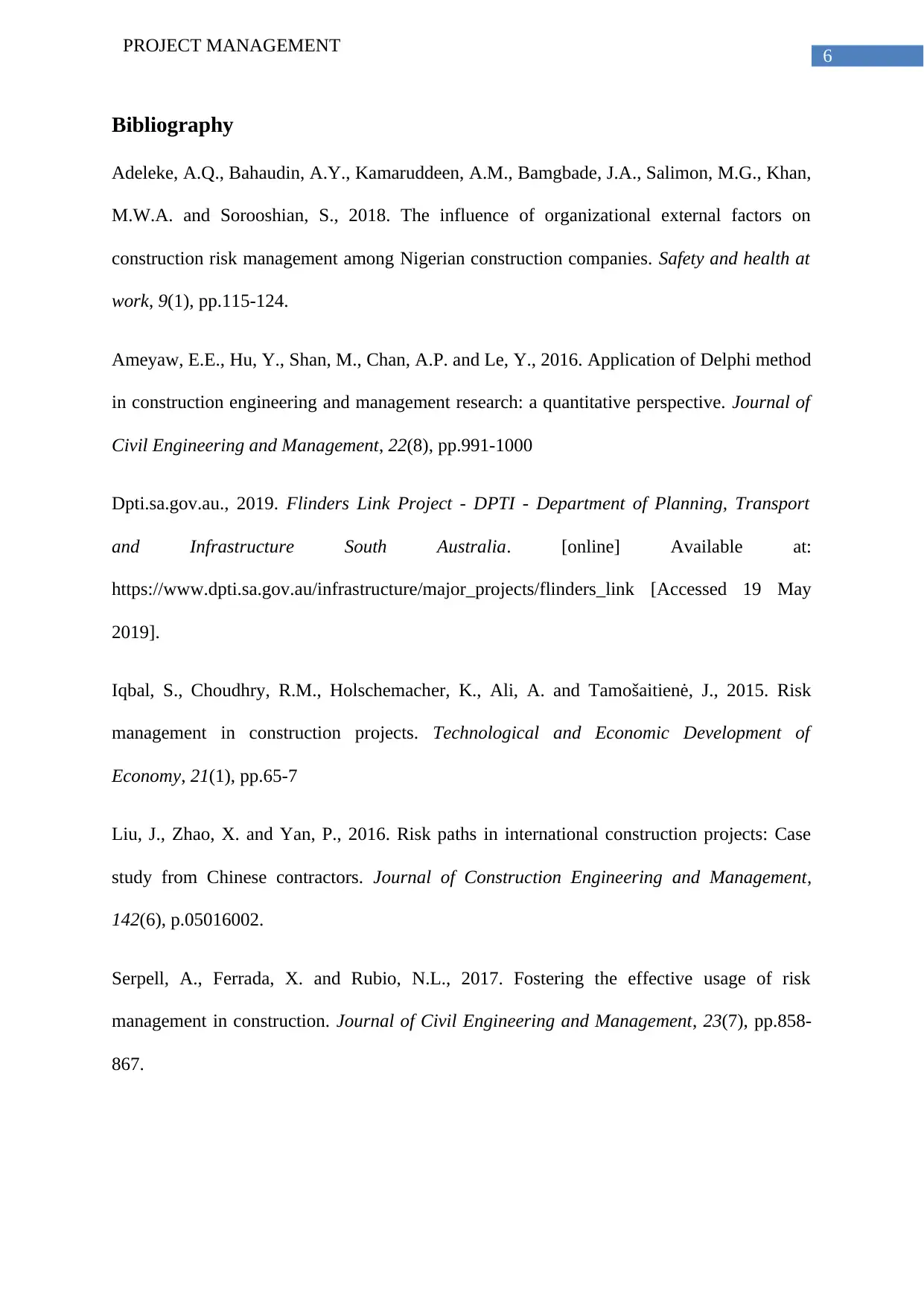
6
PROJECT MANAGEMENT
Bibliography
Adeleke, A.Q., Bahaudin, A.Y., Kamaruddeen, A.M., Bamgbade, J.A., Salimon, M.G., Khan,
M.W.A. and Sorooshian, S., 2018. The influence of organizational external factors on
construction risk management among Nigerian construction companies. Safety and health at
work, 9(1), pp.115-124.
Ameyaw, E.E., Hu, Y., Shan, M., Chan, A.P. and Le, Y., 2016. Application of Delphi method
in construction engineering and management research: a quantitative perspective. Journal of
Civil Engineering and Management, 22(8), pp.991-1000
Dpti.sa.gov.au., 2019. Flinders Link Project - DPTI - Department of Planning, Transport
and Infrastructure South Australia. [online] Available at:
https://www.dpti.sa.gov.au/infrastructure/major_projects/flinders_link [Accessed 19 May
2019].
Iqbal, S., Choudhry, R.M., Holschemacher, K., Ali, A. and Tamošaitienė, J., 2015. Risk
management in construction projects. Technological and Economic Development of
Economy, 21(1), pp.65-7
Liu, J., Zhao, X. and Yan, P., 2016. Risk paths in international construction projects: Case
study from Chinese contractors. Journal of Construction Engineering and Management,
142(6), p.05016002.
Serpell, A., Ferrada, X. and Rubio, N.L., 2017. Fostering the effective usage of risk
management in construction. Journal of Civil Engineering and Management, 23(7), pp.858-
867.
PROJECT MANAGEMENT
Bibliography
Adeleke, A.Q., Bahaudin, A.Y., Kamaruddeen, A.M., Bamgbade, J.A., Salimon, M.G., Khan,
M.W.A. and Sorooshian, S., 2018. The influence of organizational external factors on
construction risk management among Nigerian construction companies. Safety and health at
work, 9(1), pp.115-124.
Ameyaw, E.E., Hu, Y., Shan, M., Chan, A.P. and Le, Y., 2016. Application of Delphi method
in construction engineering and management research: a quantitative perspective. Journal of
Civil Engineering and Management, 22(8), pp.991-1000
Dpti.sa.gov.au., 2019. Flinders Link Project - DPTI - Department of Planning, Transport
and Infrastructure South Australia. [online] Available at:
https://www.dpti.sa.gov.au/infrastructure/major_projects/flinders_link [Accessed 19 May
2019].
Iqbal, S., Choudhry, R.M., Holschemacher, K., Ali, A. and Tamošaitienė, J., 2015. Risk
management in construction projects. Technological and Economic Development of
Economy, 21(1), pp.65-7
Liu, J., Zhao, X. and Yan, P., 2016. Risk paths in international construction projects: Case
study from Chinese contractors. Journal of Construction Engineering and Management,
142(6), p.05016002.
Serpell, A., Ferrada, X. and Rubio, N.L., 2017. Fostering the effective usage of risk
management in construction. Journal of Civil Engineering and Management, 23(7), pp.858-
867.
Paraphrase This Document
Need a fresh take? Get an instant paraphrase of this document with our AI Paraphraser

7
PROJECT MANAGEMENT
Zheng, X., Le, Y., Chan, A.P., Hu, Y. and Li, Y., 2016. Review of the application of social
network analysis (SNA) in construction project management research. International journal
of project management, 34(7), pp.1214-1225.
Zou, Y., Kiviniemi, A., and Jones, S. W., 2017. Retrieving similar cases for construction
project risk management using Natural Language Processing techniques. Automation in
Construction, 80, 66-76.
PROJECT MANAGEMENT
Zheng, X., Le, Y., Chan, A.P., Hu, Y. and Li, Y., 2016. Review of the application of social
network analysis (SNA) in construction project management research. International journal
of project management, 34(7), pp.1214-1225.
Zou, Y., Kiviniemi, A., and Jones, S. W., 2017. Retrieving similar cases for construction
project risk management using Natural Language Processing techniques. Automation in
Construction, 80, 66-76.
1 out of 8
Related Documents
Your All-in-One AI-Powered Toolkit for Academic Success.
+13062052269
info@desklib.com
Available 24*7 on WhatsApp / Email
![[object Object]](/_next/static/media/star-bottom.7253800d.svg)
Unlock your academic potential
Copyright © 2020–2025 A2Z Services. All Rights Reserved. Developed and managed by ZUCOL.





